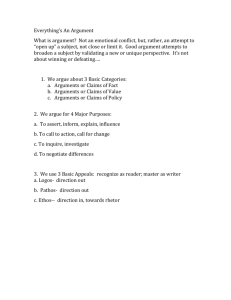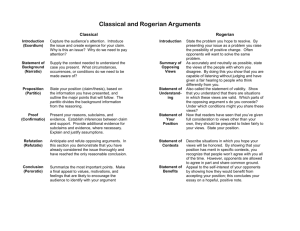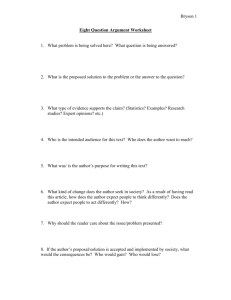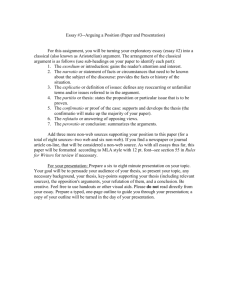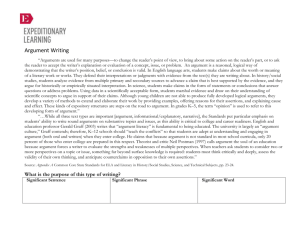Classical Argument
advertisement
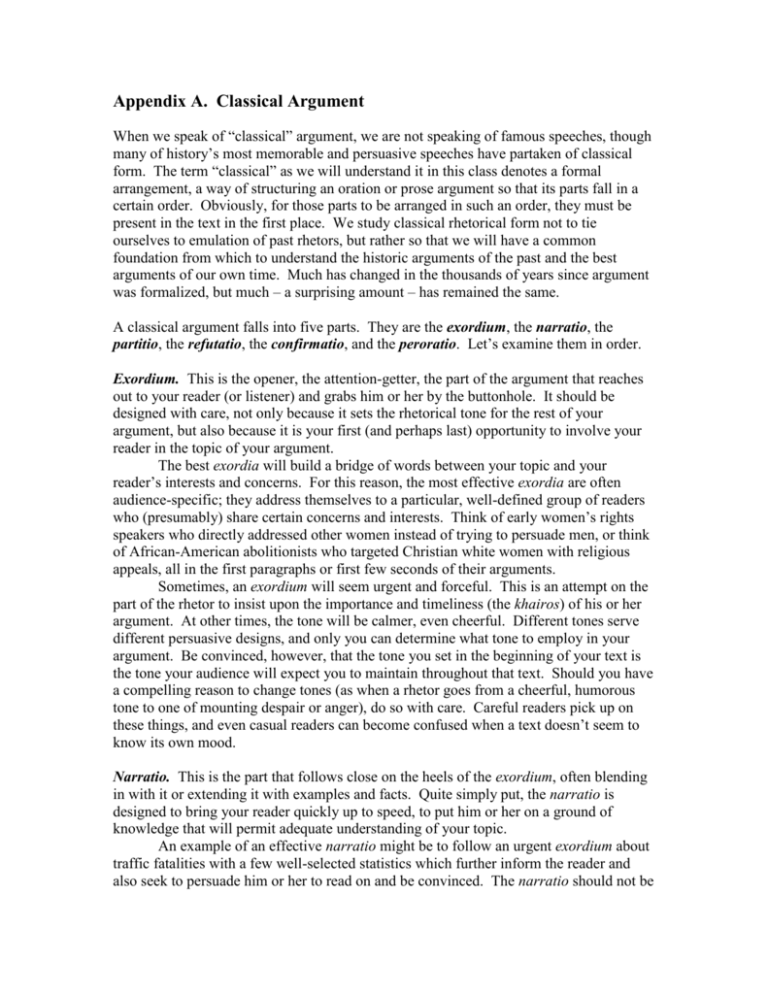
Appendix A. Classical Argument When we speak of “classical” argument, we are not speaking of famous speeches, though many of history’s most memorable and persuasive speeches have partaken of classical form. The term “classical” as we will understand it in this class denotes a formal arrangement, a way of structuring an oration or prose argument so that its parts fall in a certain order. Obviously, for those parts to be arranged in such an order, they must be present in the text in the first place. We study classical rhetorical form not to tie ourselves to emulation of past rhetors, but rather so that we will have a common foundation from which to understand the historic arguments of the past and the best arguments of our own time. Much has changed in the thousands of years since argument was formalized, but much – a surprising amount – has remained the same. A classical argument falls into five parts. They are the exordium, the narratio, the partitio, the refutatio, the confirmatio, and the peroratio. Let’s examine them in order. Exordium. This is the opener, the attention-getter, the part of the argument that reaches out to your reader (or listener) and grabs him or her by the buttonhole. It should be designed with care, not only because it sets the rhetorical tone for the rest of your argument, but also because it is your first (and perhaps last) opportunity to involve your reader in the topic of your argument. The best exordia will build a bridge of words between your topic and your reader’s interests and concerns. For this reason, the most effective exordia are often audience-specific; they address themselves to a particular, well-defined group of readers who (presumably) share certain concerns and interests. Think of early women’s rights speakers who directly addressed other women instead of trying to persuade men, or think of African-American abolitionists who targeted Christian white women with religious appeals, all in the first paragraphs or first few seconds of their arguments. Sometimes, an exordium will seem urgent and forceful. This is an attempt on the part of the rhetor to insist upon the importance and timeliness (the khairos) of his or her argument. At other times, the tone will be calmer, even cheerful. Different tones serve different persuasive designs, and only you can determine what tone to employ in your argument. Be convinced, however, that the tone you set in the beginning of your text is the tone your audience will expect you to maintain throughout that text. Should you have a compelling reason to change tones (as when a rhetor goes from a cheerful, humorous tone to one of mounting despair or anger), do so with care. Careful readers pick up on these things, and even casual readers can become confused when a text doesn’t seem to know its own mood. Narratio. This is the part that follows close on the heels of the exordium, often blending in with it or extending it with examples and facts. Quite simply put, the narratio is designed to bring your reader quickly up to speed, to put him or her on a ground of knowledge that will permit adequate understanding of your topic. An example of an effective narratio might be to follow an urgent exordium about traffic fatalities with a few well-selected statistics which further inform the reader and also seek to persuade him or her to read on and be convinced. The narratio should not be lengthy. Lengthier facts and examples (what we will call “proofs”) should be reserved for later in the argument. The narratio can, however, hint that these lengthier proofs might be forthcoming. A narratio can also remind readers of certain commonly-held values, especially if the text in question is ceremonial or epideictic., or if it plans to use cultural values as an authorizing trope. If these last few words sound unfamiliar, refer to Kinds of Argument, also in this reader. For best results, the narratio should be carefully crafted so that it flows gracefully from the exordium and then terminates logically with the partitio. Partitio. This is what most of us call the “thesis.” A well-crafted partitio, however, is more than a text-book high-school thesis sentence. It makes a promise to the reader. It says, in its own way, “I will convince you of X, and I will do so in the following ways.” Think of a good partitio as a road map for your reader, informing him or her nont only of the destination (your thesis), but also of the major landmarks along the way (the points you will address). The tough thing about crafting a really good partitio is just keeping it short. You may have to fight the urge to say too much up front. Don’t give in to this urge. A brief, direct, and reasonably complete partitio will be no longer than a couple of sentences, in the case of a short argument. It looks something like this: “Contrary to the cries of the religious Right, gay marriage is less threatening to the institution of matrimony that are alcoholism, a sluggish economy, and the decline of the traditional neighborhood in urban America.” What this partitio accomplishes is, first, to establish the point to be proven – that gay marriage is not as threatening as the religious Right makes it out to be, or is at least less threatening than other social problems. In making this claim, the partitio suggests to the reader that the views of the religious Right will be challenged later (in the refutatio), but we’ll get to that in time. This particular partitio also lists the subtopics the argument will take up: alcoholism, the economy, and the vanishing urban neighborhood. The reader has a right to expect that all these things will get a fuller treatment in the body of the argument, and a careful rhetor will make sure that they do. This brings us to what we call our proofs. There are two kinds of proofs in classical argument. The positive proof is called confirmatio, and the negative proof is called refutatio. They can occur in any order in the body of the argument, but most arguments about topics that really matter will call for both kinds of proofs. Let’s look at those proofs now. Confirmatio. When we make a claim which supports our point, and then seek to convince our reader of its truth, we are engaging in confirmatio. If it helps, think of these proofs as “confirming” your claims. These are the kinds of proofs we are most familiar with, the kinds we were taught to provide in our high school arguments. They back up claims with evidence and example, or with reasoning for those claims which cannot be proven empirically (such as claims of value). In the above example fo a partitio, for instance, I promised my reader that I would prove the harm that alcoholism does to the institution of marriage in the United States. Here, in the part of the argument’s body devoted to confirmation, is where I get to work on that, providing my reader with statistics, examples, facts, personal or second-hand accounts, and whatever else counts as evidence for my claim. I will try to persuade my reader that alcoholism is more dangerous to American marriages than gay union, and while I won’t be able to persuade every reader (we can never persuade everyone), I will try to pull the majority over to my side of the issue. That’s what confirmatio is all about. Refutatio. The kind of proof which is often neglected in high school writing courses is the refutation. As its name suggests, this is the kind of proof which seeks to refute or invalidate an opposing claim or argument. In my sample partitio, above, I hinted that I would take on the arguments of the religious Right in the body of my argument. Here, in my refutatio, is where that struggle takes place. Obviously, in order to engage these arguments successfully, I have to know what they are, which means I have to read the arguments of my major opponents on their merits, treating them seriously, and not merely ridiculing them or seeking to build a straw man I can thrash more easily than the real arguments. Why is this important? Two reasons. First, some members of your audience may get a chuckle out of watching you badmouth an opponent, but those folks aren’t the ones you need to persuade. They’re already in your camp. No, the ones you need to convince are the undecided, the ones who are still taking the real arguments of your opposition seriously. You can’t win them over by insulting something they may actually believe in. Instead, you have to show them that there are serious flaws in the actual arguments of your opposition. The refutatio, then, is a tricky balancing act. On the one hand, you have to treat the arguments of your major opponents with some degree of respect. But on the other hand, you have to make your points forcefully and completely. You cannot hem and haw, hedging around with statements like “some people believe one thing, but others believe something else.” This is a dodge, and even casual readers will recognize it as such. What’s more, it is self-evident, and your reader will view it as a deliberate waste of his or her time. That certainly won’t win you any converts, will it? Peroratio. To paraphrase Cicero, once we’ve carefully navigated the shoals of evidence and counter-evidence, it’s time to put all our sheets to the wind. This is the big finish, the peroratio. We are accustomed to calling this the “conclusion,” and that’s fine if you want to call it that. But remember that logicians use the word “conclusion” to refer to what composition teachers commonly call the “thesis.” This can get a bit confusing if you’re talking to a philosopher, but most of us don’t spend much time doing that anyway. The peroratio is your closer. It’s the pont at the end of the argument when you remind your reader in fresh words what has been proven, when you exhort him or her once more to act upon, think about, or change something, and when you once again provide a bridge, this time from the world of your argument to the world of your audience. Students complain about “conclusions” even more frequently than they complain about “introductions.” At least with an “introduction,” you know you have to have an attention-getter and a thesis, right? So what do you do with a “conclusion”? There are any number of functions a peroratio can perform, but perhaps it’s best to think of this part of the essay as the big shiny bow on the gift-wrapping. The argument is done. The proofs have been delivered as carefully and as forcefully as possible. Now it’s time to tie everything up in a memorable package and send it out into the world to take its chances. But how? One option, of course, is to remind your audience of the things you’ve already proven. This is white I call the “Q.E.D.” peroratio, for quod erat demonstrandum (“which was to be proven”). It simply tells the reader, “Look, I told you I’d prove this, and I proved it.” Beware, however, of heeding the mistaken advice often given to high school students. Do not repeat your thesis in your conclusion! This is not only unnecessary (your readers can always go back and re-read your thesis if they need to – and they shouldn’t need to!), but it also gives the impression that nothing has really been proven. Remember I compared the partition to a road map? Well, who wants a road map that just brings the driver right back to where he or she started? No, your peroration should, above all, leave the reader with the strong impression that something has been proven, that something is finished, and that he or she hasn’t wasted the time it took to read your argument. Once common approach to strongly argumentative essays is to finish with a “call to action” peroration. Especially in the case of arguments of policy, the call to action seeks to take the essay beyond mere words on a page and transform it into a reason for doing something, whether that means voting for a particular candidate, speaking out against a program or practice, or just going out and getting more exercise. The “call to action” peroration seeks to inspire action and bring about change. Of course, a peroration can also attempt exactly the opposite. Imagine a rhetor who questions the necessity or legality of a proposed new law, and who writes in favor of the status quo. This is still a kind of “call to action,” though rather than saying “Go get this done,” it cautions readers to “Look before you leap.” Such arguments are more common than many of us realize. Some kinds of peroration will try to paint pictures with words, giving readers a glimpse of what things might be like if the advice of the argument is (or is not) followed. Painting a picture of things to come, whether a rosy vista or a bleak panorama, is an appropriate way to finish an argument of policy, and many writers and speakers resort to such endings. The trick here is to avoid becoming cartoonish by going overboard. It’s also important that we avoid seeming to create a false dilemma in our peroration that will be spotted by our readers. If I argue against metal detectors at a local school, then conclude my essay by predicting that such measures will lead to a fascist state and the end of the American family, my readers will probably suspect me of being off my medication, and they’re less likely to follow my advice than if I’d played my cards a little closer to my vest (perhaps by describing the psychological harm done to a generation of school kids who think their society fears and mistrusts them). However you end your argument, you should remember that the last paragraphs are as important as the first, if not more important. While the first paragraphs set the tone of your essay and present the reader with a reason for reading on, the peroration sends the reader back out into the world with a final impression. The strength of that final impression can make or break an argument. Now that we’ve examined the parts of the classical argument, it is important that we remember not to look at this formal structure as some kind of strait-jacket keeping us from expressing ourselves effectively. These days, many writers take great liberties with form in their arguments, though the most careful and graceful writers of commentary and opinion pieces (not to mention speeches) give at least a nod to classical arrangement. Feel free to move parts around, to extend some parts, and to shorten others. Recall that persuasion is the goal of argumentative writing, and sometimes persuasion requires us to modify formal rules to suit the topic and the audience. That’s fine. In fact, that’s khairos. Just don’t let your argument become so formless that it degenerates into a rant or a whimper. Although some folks who write in this way do end up being published, they are not generally taken very seriously by readers who don’t already agree with them. That means their power to persuade the unconvinced is limited, at best. If you’re just looking to blow off steam, write however you like, using whatever tone you feel suits your mood, but if you’re really seeking to persuade an audience, you must address not only your tone, but also your diction and your formal structure to that audience. Argument is not a game of solitaire where we can express ourselves however we like; it is a game with winners and losers. Our goal, as persuasive writers, is to win.
